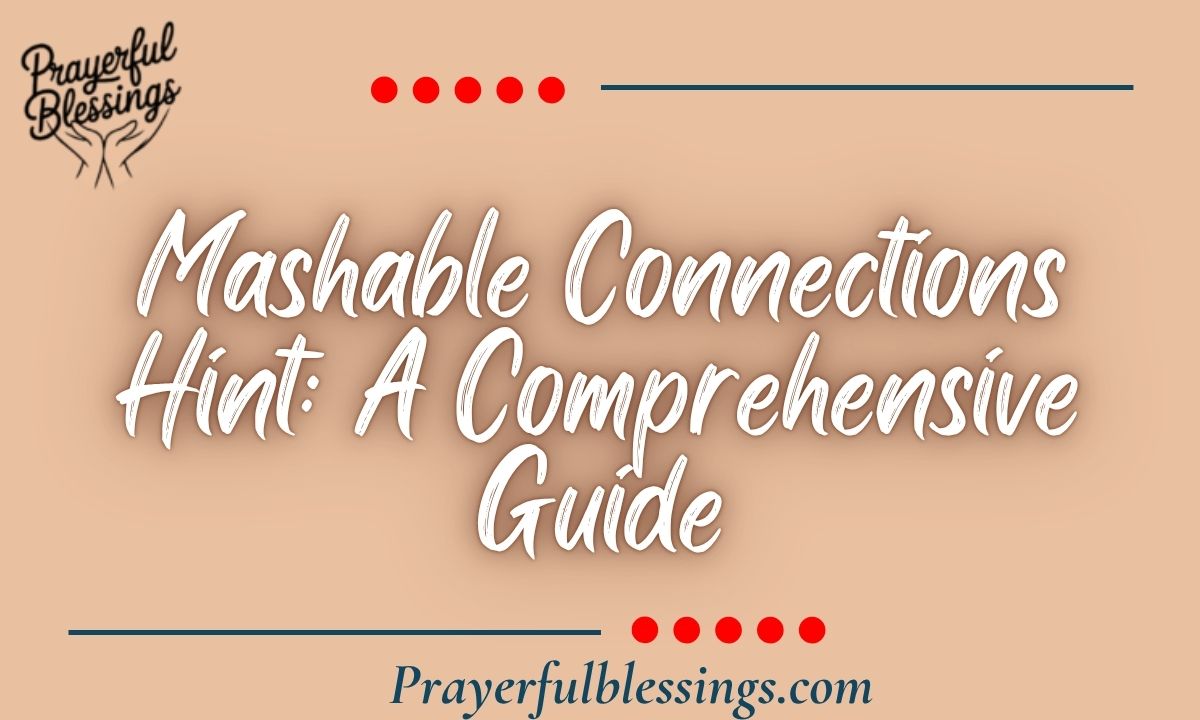The NYT Connections puzzle has taken the internet by storm. Millions of players worldwide tackle this brain teaser daily. But sometimes, you need a little nudge in the right direction. That’s where Mashable Connections hints come into play.
This guide breaks down everything you need to know. You’ll learn puzzle-solving strategies, avoid common mistakes, and understand why these hints are so valuable. Let’s dive into the world of word grouping and pattern recognition.
Whether you’re a beginner or a seasoned solver, this resource will sharpen your skills. Get ready to transform your puzzle-solving game completely.
What Even Is the NYT Connections Puzzle, Anyway?
The New York Times Connections is a daily word puzzle launched in 2023. Players receive sixteen words that must be sorted into four groups of four. Each group shares a common theme or connection.
The puzzle comes with four difficulty levels represented by colors. Yellow represents the easiest category, followed by green, then blue, and finally purple for the most challenging. You have only four mistakes allowed before the game ends.
The genius lies in the deceptive simplicity. Words often belong to multiple potential categories. The challenge is identifying the intended groupings. One wrong move can cascade into total confusion.
How the Puzzle Works
Here’s the basic gameplay structure:
- 16 words appear on your screen in a random arrangement
- 4 categories of 4 words each need to be identified
- 4 mistakes are permitted before game over
- Color-coded difficulty guides your strategic approach
| Difficulty Level | Color | Typical Characteristics |
| Easiest | Yellow | Straightforward associations, common knowledge |
| Moderate | Green | Requires broader vocabulary and lateral thinking |
| Challenging | Blue | Obscure connections, wordplay elements |
| Hardest | Purple | Highly abstract, multiple potential meanings |
The puzzle resets daily at midnight. Each new puzzle brings fresh challenges. The satisfaction of solving it drives millions of daily players.
So, What’s This “Mashable Connections Hint System” Everyone’s Talking About?
Mashable Connections hints are strategic clues published alongside the daily puzzle. They provide guidance without spoiling the solution entirely. Think of them as breadcrumbs leading you toward the answer.
Mashable’s tech and entertainment website offers these hints daily. They’ve become incredibly popular among puzzle enthusiasts. The hints strike a perfect balance between helpful and challenging.
Unlike direct answers, these hints encourage critical thinking. They nudge you in the right direction. You still experience the satisfaction of solving independently.
Types of Hints Mashable Provides
Mashable typically offers three levels of hints:
- Vague category hints – Broad thematic suggestions
- More specific clues – Narrower guidance about connections
- Almost-there hints – Very direct pointers for struggling solvers
The beauty is choosing your hint level. You control how much assistance you receive. This preserves the puzzle’s challenge while preventing frustration.
Mashable Connections Hint System: Not Just Training Wheels
Many people think hints are for beginners only. This couldn’t be further from the truth. Even expert solvers consult hints strategically.
The hint system teaches pattern recognition skills. It exposes you to thinking frameworks you might not discover alone. Over time, you internalize these approaches.
Using hints isn’t cheating—it’s strategic learning. Professional puzzle solvers use similar techniques. They study solved puzzles to understand constructor thinking patterns.
Benefits Beyond Just Solving
- Vocabulary expansion through exposure to word relationships
- Pattern recognition skills that transfer to other areas
- Reduced frustration that keeps you engaged long-term
- Learning opportunities from understanding why connections work
Think of hints as having a puzzle mentor. They accelerate your learning curve. Eventually, you’ll need them less frequently as your skills develop.
Strategies to Solve the NYT Connections Puzzle Faster
Want to improve your solving speed? These proven strategies will transform your approach. Start implementing them today for immediate results.
First, scan for the most obvious connections. Yellow category words usually jump out quickly. Identifying easy groups first provides momentum and reduces board complexity.
Look for words with multiple meanings carefully. These are intentional red herrings. The puzzle constructor wants you to see false connections. Train yourself to question initial assumptions.
Step-by-Step Solving Process
Initial Assessment Phase:
- Read all 16 words without making selections
- Note any immediate, obvious connections
- Identify words with multiple potential meanings
- Look for proper nouns, which often group together
Strategic Grouping Phase:
- Start with yellow (easiest) category first
- Work methodically through color levels
- Use process of elimination
- Save purple (hardest) for last
Verification Techniques:
- Ask yourself: “Why do these FOUR words connect?”
- Check if any word could belong to multiple groups
- Verify the connection is specific and complete
- Ensure no overlap between categories
Common word categories to watch for include:
- Synonyms or related words
- Words that precede or follow a common word
- Items in a series or sequence
- Homophones or wordplay connections
- Pop culture references
- Technical or specialized vocabulary
Time yourself to track improvement. Most experienced solvers complete puzzles in 2-5 minutes. Don’t worry if you’re slower initially—speed comes with practice.
Real-World Walkthrough: Let’s Solve One Together
Nothing beats learning through example. Let’s walk through a sample puzzle step-by-step. This demonstrates how to apply strategies practically.
Imagine these 16 words appear: BANK, POOL, TABLE, TRUST, SPRING, FALL, BILL, CHECK, RESERVE, CABINET, DRAWER, SUMMER, WINTER, COUNTER, SAFE, VAULT.
First scan reveals potential season words: SPRING, FALL, SUMMER, WINTER. This seems like an obvious yellow category. Let’s test it.
Breaking Down the Solution
Step 1: Seasons group confirmed – SPRING, FALL, SUMMER, WINTER
Step 2: Banking/finance terms emerge – BANK, RESERVE, VAULT, TRUST (or possibly CHECK, BILL)
Step 3: Furniture with storage – CABINET, DRAWER, SAFE, COUNTER (wait, or are these kitchen items?)
Step 4: Remaining words need reconsideration – POOL, TABLE, BILL, CHECK
Notice the confusion? This is intentional. POOL TABLE might be relevant. BILL and CHECK could mean restaurant items. The key is testing theories systematically.
The actual solution might be:
- Seasons: SPRING, FALL, SUMMER, WINTER
- Federal Reserve terms: BANK, RESERVE, CABINET, BILL (as in Treasury)
- Games: POOL, TABLE, CHECK (chess), TRUST (trust fall exercise)
- Storage furniture: DRAWER, COUNTER, VAULT, SAFE
This example shows why the puzzle is tricky. Words have multiple valid interpretations. The correct answer requires identifying the constructor’s intended connection.
Common Mistakes People Make (And How to Dodge ‘Em Like a Space Rock)
Everyone makes mistakes solving Connections. Recognizing these common pitfalls helps you avoid them. Learn from others’ errors to improve faster.
The biggest mistake is rushing. Players see three words that connect and immediately select a fourth without verification. That fourth word often belongs elsewhere.
Another trap is confirmation bias. You see a potential connection and force words to fit. Your brain ignores evidence contradicting your theory. Fight this tendency actively.
Top 10 Mistakes to Avoid
- Selecting three words too quickly – Always identify all four before submitting
- Ignoring color difficulty levels – Start with yellow, save purple for last
- Missing wordplay connections – Consider puns, homophones, and double meanings
- Overlooking proper nouns – Names often group together
- Forcing connections – If it feels awkward, it probably is
- Not using all four mistakes – They’re there for experimenting
- Giving up on purple category – Sometimes it’s the simplest connection
- Ignoring visual patterns – Word length or structure might matter
- Forgetting about phrases – “Bank on it,” “Table the discussion,” etc.
- Playing when tired – Mental fatigue kills puzzle performance
When you make a mistake, don’t panic. You have three more chances. Use each error as information. Eliminate that connection possibility and reconsider remaining options.
How to Write Your Own “Mashable-Style” Hints (Yes, You Can)
Creating effective hints is an art form. Understanding this process improves your solving skills. You learn to think like puzzle constructors and hint writers.
Good hints provide directional guidance without revealing answers. They use metaphors, related concepts, or thematic suggestions. The best hints make solvers say “Aha!” not “Oh, you just told me.”
Practice writing hints for puzzles you’ve already solved. This trains your brain to see connections from multiple angles. You’ll become better at identifying patterns.
Hint Writing Framework
For Yellow Category (Easy):
- Use direct thematic references
- “Think about what you do in autumn”
- “Consider items you’d find in this room”
For Green Category (Moderate):
- Employ slightly abstract language
- “These all share a common prefix/suffix”
- “Think about a famous phrase or saying”
For Blue Category (Challenging):
- Use lateral thinking prompts
- “Consider alternative meanings”
- “What word could come before/after all these?”
For Purple Category (Hard):
- Provide minimal, cryptic guidance
- “Look beyond the obvious”
- “Think about unexpected connections”
Test your hints on friends. If they solve too quickly, you revealed too much. If they’re completely lost, add slight clarity. Finding the sweet spot takes practice.
Cognitive Benefits of Puzzle Solving (Science Time!)
Solving word puzzles isn’t just entertainment. Research shows significant cognitive benefits. Your brain literally changes from regular puzzle practice.
Studies demonstrate improved working memory in frequent puzzle solvers. The constant mental juggling strengthens neural pathways. This benefit extends beyond puzzles into daily life.
Pattern recognition skills develop dramatically. You become better at identifying relationships and connections. These skills apply to problem-solving in work and personal contexts.
Scientific Research Findings
| Cognitive Benefit | Research Evidence | Real-World Application |
| Memory Enhancement | 15-20% improvement in recall tasks | Better retention of information |
| Processing Speed | Faster decision-making abilities | Improved workplace efficiency |
| Mental Flexibility | Enhanced creative thinking | Better problem-solving skills |
| Delayed Cognitive Decline | 2.5 year delay in dementia symptoms | Healthier aging process |
Regular puzzle solving releases dopamine, the reward neurotransmitter. This creates positive associations with challenging mental work. You literally train your brain to enjoy difficult thinking.
The social aspect matters too. Discussing puzzles with others builds community. Shared experiences and friendly competition enhance motivation. This social engagement provides additional mental health benefits.
Neuroplasticity—your brain’s ability to form new connections—increases with puzzle practice. At any age, you can strengthen cognitive abilities. The key is consistent practice over time.
Final Thoughts
The NYT Connections puzzle offers more than daily entertainment. It’s a mental workout that sharpens your mind. Combined with Mashable hints, it becomes an accessible learning tool.
Don’t feel guilty about using hints strategically. They’re educational resources, not shortcuts. The goal is enjoying the process while developing skills. Find your perfect balance between challenge and assistance.
Remember that improvement takes time. Track your progress over weeks and months. Celebrate small victories like solving without hints or identifying purple categories quickly. Every puzzle makes you sharper.
The puzzle community is welcoming and supportive. Share your experiences online. Learn from others’ strategies. The collective wisdom of millions of daily solvers is invaluable. You’re part of something bigger.
Keep practicing, stay curious, and enjoy the journey. Your future self will thank you for investing in cognitive fitness today. Happy puzzling!
Frequently Asked Questions
What time does the NYT Connections puzzle reset?
The puzzle resets at midnight local time based on your device settings. A fresh challenge appears daily for you to solve.
Are Mashable hints considered cheating?
No, hints are learning tools designed to help you improve. They provide guidance while preserving the solving experience and satisfaction.
How many mistakes am I allowed?
You get four mistakes before the game ends. Use them strategically to test theories and eliminate incorrect groupings.
What’s the hardest Connections color?
Purple is consistently the most difficult category. It often involves wordplay, obscure connections, or highly abstract thinking requirements.
Can I play past Connections puzzles?
Not officially through NYT. However, archives and fan sites sometimes maintain previous puzzles for practice purposes.
Do I need a NYT subscription?
Currently, Connections is free to play without a subscription. This may change as the puzzle continues growing in popularity.
How do I get better at spotting purple categories?
Practice looking for non-obvious connections. Think about phrases, idioms, prefixes/suffixes, and words that can precede/follow a common term.
Why do some words seem to fit multiple categories?
This is intentional design. The puzzle challenges you to identify the constructor’s intended grouping among multiple possibilities.
Should I start with easy or hard categories?
Always start with yellow (easy) categories. Removing obvious groups first simplifies the board and reduces potential confusion.
How long does the average person take to solve?
Most players complete puzzles in 3-10 minutes. Experienced solvers often finish in under 3 minutes with consistent daily practice.
Can Connections improve my vocabulary?
Absolutely! Regular play exposes you to diverse word relationships and meanings you might not encounter otherwise. Learning happens naturally.
What if I can’t solve the purple category?
Don’t stress! Purple is meant to be extremely challenging. Using all four mistakes on it is completely normal and acceptable.

Meet Eman, the heart and soul behind PrayerfulBlessings! With a deep understanding of prayers and blessings, she crafts heartfelt messages that inspire and uplift. Whether you’re seeking comfort, guidance, or strength, Eman’s carefully crafted prayers offer a sense of peace and hope. Let her words bring warmth and positivity to your day, filling your heart with faith and gratitude. Get ready to experience the power of prayer!

